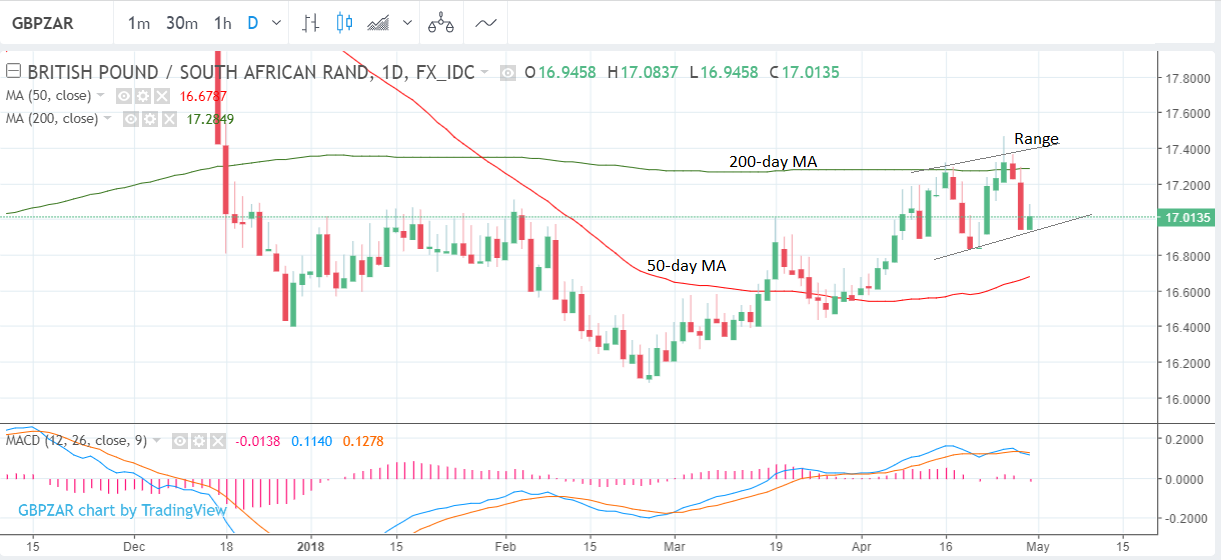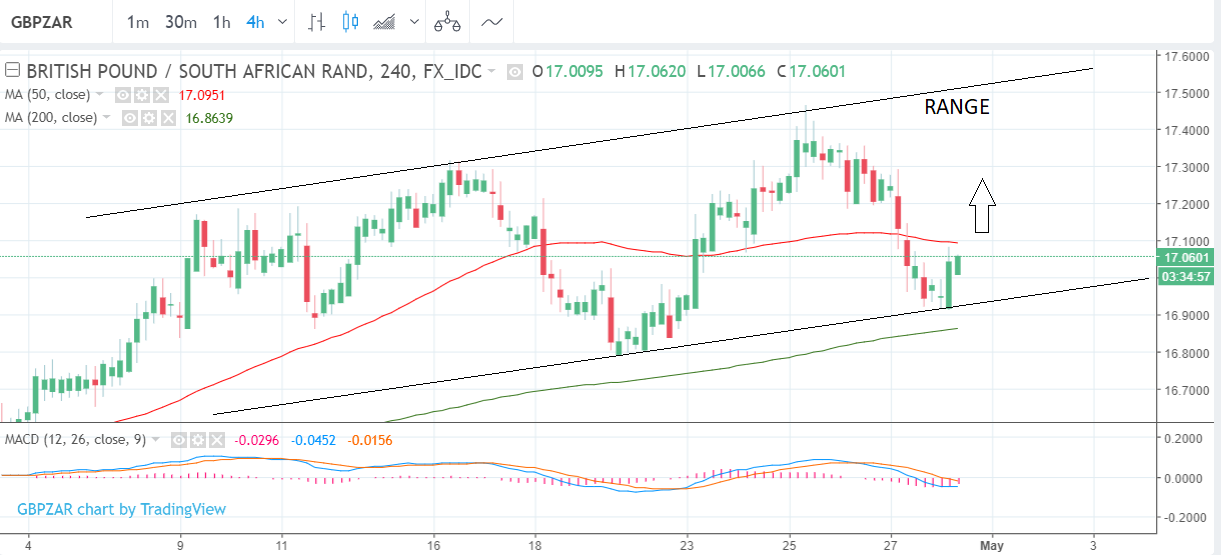The Pound-to-Rand Rate's Forecast for Week Ahead
- GBP/ZAR has potential to rise back up to the range highs at 17.30
- Main releases for the Pound this week are PMI surveys for Manufacturing and Services
- Similarly in South Africa PMI's also constitute the main releases

© Natanael Ginting, Adobe Stock
One Pound buys 17.08 South African Rand at the time of writing with the Pound marginally higher compared to the previous week when the exchange rate closed at 16.95.
Looking at the exchange rate from a technical perspective, the GBP/ZAR appears to be trading in a range between roughly 16.80/90 and 17.30/40.
It is currently at the bottom of the range.
The range highs are capped by the 200-day moving average (MA) at 17.29 which appears to be obstructing further upside progress.
On the 4-hour chart below we see a recovery beginning from the lower borderline of the range. The last two periods have shown strong upside and although the exchange rate has just met the 50-4hr MA it is not major enough to cap gains and the exchange rate could easily break above it and continue up to the top of the range again.
Sideways ranges are typically difficult to forecast so we have decided that it is more prudent on balance to adopt a neutral stance until a stronger trend starts to develop and we will be taking more guidance from fundamental drivers as a result.
Indeed, all eyes will be on the U.K. economy once more as traders look for signs that last week's disappointing GDP data release has had its full impact on Sterling.
Get up to 5% more foreign exchange by using a specialist provider to get closer to the real market rate and avoid the gaping spreads charged by your bank when providing currency. Learn more here.
Data and Events for the Pound
The main data release for the Pound in the week ahead will be the release of April Service and Manufacturing PMIs out at 9.30 on Thursday and Tuesday respectively.
PMI is short for Purchasing Manager Index, and PMIs are survey-based indicators which are seen as useful forward-indicators of economic activity.
The market consensus appears to be for expecting a rebound in Services in April after the drop in March, which was put down, mainly to bad weather. Services PMI in April is expected to rise to 53.5 from 51.7 and Manufacturing to 54.8 from 55.1.
The Pound may be especially sensitive to the results this week owing to the laser-like focus currency markets are currently placing on UK economic data.
Sterling fell by over a percent against both the Euro and US Dollar in the wake of economic growth data which revealed the UK economy grew a mere 0.1% in the first three months of 2018, growth that has virtually killed any prospect of an interest rate rise being delivered by the Bank of England (BOE) in May.
Will the incoming data surveys point to a pick-up in activity, or will they suggest the economic slowdown is more entrenched?
From the market expecting a hike with almost 100% certainty a few weeks ago, the probabilities have now fallen to circa 50% after comments from the governor of the BoE suggested there might be a delay owing to the downturn in data.
The possibility of a delay in raising rates led to a drop in the Pound which is highly sensitive to interest rate expectations.
Expectations of higher rates tends to lift the Pound and vice versa for the lower rates. This is because higher rates tend to attract greater inflows of foreign capital drawn by the promise of higher returns and this increases demand for the Pound.
"We may see an outsized market reaction from any surprises, as they tilt markets toward or away from a May BoE hike," says Canadian investment bank TD Securities in their note on the week ahead.
The bullish market forecasts for Manufacturing are not shared by some, including Philip Shaw, an analyst at Investec, who sees risks to April's figure both from the sharp appreciation in the Pound and the heightened talk of a trade war in early April.
Shaw does, however, share the market's more upbeat forecast for Services, which he expects to rebound by three points to 54.7 due to the temporary impact of bad weather dissipating.
More generally the lack of market-moving data besides PMIs means the weak could be a slow one for the Pound.
"Domestically, next week may represent a lull before the storm provided by the 10 May Bank of England Inflation Report and MPC announcement," says Shaw. "Bearing in mind Mark Carney’s comments last week about mixed data, the decision may be more finely balanced than we had envisaged."
"But we judge that the MPC will believe that the tight labour market will override the softer than expected short-term inflation environment," concludes the analyst.
The other major event in the week ahead for the Pound is the UK local elections on Thursday, May 3 at 1.00 GMT.
The main way it could impact is via Brexit expectations, such as for example if there is a surprise outsized vote for the anti-Brexit liberal democrats, which might be Sterling positive.
If the Conservatives win a larger-than-expected majority it could impact on Sterling in two ways depending on how investors interpret the result.
It could be negative for Sterling because the Conservative party is probably the party most in favour of the 'harder' forms of Brexit.
At the same time is could be positive for the Pound if it is interpreted as showing increased confidence in Theresa May's leadership, suggesting a reduction in the influence of the far right within the party, and therefore more likely to deliver a pragmatic rather than ideologically driven Brexit solution.
A Labour landslide would be negative for Sterling, according to TD Securities.
"While polls have consistently been pointing toward big Labour wins/Conservative losses at next week's local elections, with GBP being vulnerable to political developments, we may see a negative market reaction to any "Labour landslide" headlines. Vote counting only begins on Friday, so results should trickle out later that day," say TD Securities.
It is not unusual for voters to use the local elections to express dissatisfaction with the reigning government so a labour victory would not be particularly surprising or necessarily especially indicative of future voting patterns.
Data and Events to Watch for the Rand
The main release for the Rand in the week ahead is ABSA Manufacturing PMI for April, out at 10.00 GMT on Tuesday, May 1.
The gauge came out at 46.9 in the previous month which is in contraction territory because it is under 50. A lower-than-expected result will pressure the Rand lower.
Total New Vehicle Sales in April is out on Wednesday, May 2, and markets are looking for a beat on the previous month's 46.2k.
For ZAR, we would however expect the tone to be set by global capital flows, and the drive higher in the US Dollar which is pushing up the relative cost of oil, which in turn puts pressure on emerging market economies that import energy.
We find that in an environment of a rising Dollar, the foreign-exchange denominated debt burden of developing countries such as South Africa also tends to rise.
So, the environment might be less supportive of ZAR over coming days and we watch for signs of whether this USD recovery has legs to extend.
Get up to 5% more foreign exchange by using a specialist provider to get closer to the real market rate and avoid the gaping spreads charged by your bank when providing currency. Learn more here.












